Check out our GPS vehicle tracking demo to see how AutoAlert can help you see where you’re vehicles and engineers are, respond proactively to customer queries and reduce your costs through reports such as working times, driving times, mileage, stationary times etc.
Check out our quick demo video which gives a brief introduction to our web and mobile based GPS vehicle tracking application.
https://youtu.be/E8XpigUgPjw&rel=0&w=560&h=400&showinfo=0&theme=light&enablejsapi=1
Find out more about AutoAlert GPS Vehicle Tracking or Sign up to AutoAlert.
Large fleets have generally been most able to afford the cost of vehicle tracking and turn it into an overall cost advantage.
Medium and small sized, fleets, however, could not always make that choice and have it be economical. The high cost of equipment, infrastructure, and monthly fees makes traditional vehicle tracking a difficult proposition for all but the largest of fleets.
Before you can determine if vehicle tracking is worth the cost for your own fleet operations, let’s first touch on the basic benefits that can be realized with a good system.
Less driver downtime – Knowing the location of every vehicle and driver means that emergent work and needs can be routed to available personnel quickly and more easily. This prevents drivers from spending extended periods of time waiting for dispatch or direction.
Better customer service – You are better able to serve your customers promptly and efficiently when vehicle locations can be determined quickly and easily. Thus when a new customer call or request comes in the appropriate vehicle can be dispatched right away.
Field replenishment – When vehicles in the field run low on supplies or other necessary items, a good tracking system allows delivery and restocking out in the field instead of requiring the vehicle to return to base for more materials.
Effective supervision – Fleet managers and supervisors will almost always say that they can do their jobs most effectively when they are out in the field with their drivers, rather than in the office or at a desk. Good vehicle tracking allows managers and supervisors to spend more time out in the field where they are most needed.
The typical costs associated with a traditional vehicle tracking system include the vehicle units, installation,
monthly subscription fees and other hidden fees.
The newest innovation in vehicle tracking, however, is much less expensive and brings this potentially beneficial technology within reach of even the smallest of fleets.
This technology uses smartphones or portable gps tracking devices which don’t require installation and can be monitored using a web-based interface or smartphone application allowing fleet operators to monitor and track their vehicles simply and efficiently without a large upfront outlay.
Anybody considering a vehicle tracking system would be well advised to research both traditional and new options, and do a direct comparison of costs, features and benefits. In most cases, it is likely that the newer technology will end up being the most cost effective solution.
Find out more about AutoAlert GPS Vehicle Tracking.
Most people involved with any kind of vehicle fleet are at least somewhat familiar with the benefits of fleet tracking technology. Large fleets of all kinds are nearly always equipped with some sort of tracking equipment, which allows the vehicle owners to conduct operations more efficiently and more effectively. The cost is pretty high, but when that cost is allocated across a large fleet, it becomes economical.
But what about small fleets?
The high cost of fleet tracking would seem to put it out of reach of most, if not all, small fleet operators. Thanks to new technology and an innovative application of that technology, it is now possible for vehicle tracking to be economical for small fleets, even those as small as one or two vehicles.
This new technology is revolutionary in that for the first time, a fleet operator can monitor and track vehicles through a portable GPS tracking unit, a standard mobile phone, iPhone, iPad or the web with minimal installation in the vehicle and no complicated software to download, install and understand. This means that upfront costs and operating costs are much lower and very affordable.
In contrast to traditional systems that require a large capital investment and substantial monthly fees, this is a huge advantage for small fleet owners. And if the small fleet operator wants to lower the costs even further then they can use their own SIMs.
One of the most attractive aspects of this new technology is that it tracks vehicles proactively rather than reactively. In other words, the system is constantly aware of where each vehicle is located, unlike traditional systems that depend on the vehicle owner to contact the central call centre and initiate a tracking request. It also can send customised alerts and messages to notify the operator if a vehicle is having a mechanical problem, has been stolen, or is otherwise in need of attention.
Why, exactly, is this new technology so helpful to small fleet operators? Because it allows the operator to benefit from less driver downtime, more efficient dispatch, and the freedom for fleet managers and engineers to spend their time in the field rather than in the office. And all of these things contribute to the one thing that is most compelling – increased profits due to better fleet management.
There is currently one company offering this new technology to individual consumers as well as fleet operators of all types and sizes. It is called AutoAlert and is based in the UK, but has the capability to offer service across many other countries around the world.
Regardless of the size of your fleet, the good news for your bottom line is that fleet tracking technology has changed for the better. Now more than ever, it is economical and convenient to track even small fleets efficiently, conveniently, and at a reasonable cost.
AutoAlert celebrates its 10th anniversary
Launched in 2004, AutoAlert’s award-winning fleet and job management platform has grown to become one of the most widely-adopted telematics platforms in the world, providing over 20,000 businesses with actionable insights into their operations.
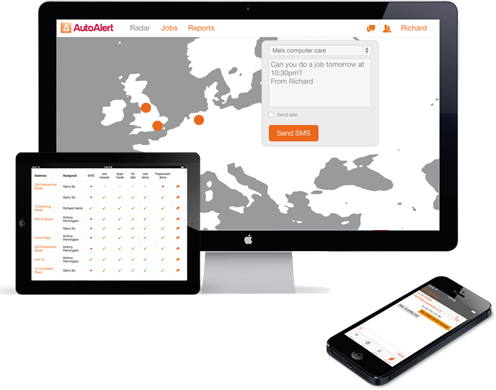
Over the last 10 years, AutoAlert has been used to improve mobile operations in sectors including transport and logistics, utilities, construction, meal delivery, breakdown assistance and car-sharing schemes.
To celebrate its 10th birthday, we’ve sought out some of the surprising and unusual ways AutoAlert has been put to use in a variety of locations around the globe:
“The innovative approach to fleet management established 10 years ago remains as strong today and AutoAlert continues to evolve, providing customers with ever smarter ways to meet their business goals.” said Richard Harris, Managing Director, AutoAlert GPS Tracking, Job Management and Messaging.
Find out more about AutoAlert’s features and how it can benefit your business.
Its often easier to see where you’re drivers are than them trying to work out their location from a small screen or from road signs alone.
You might also need to send a new route to a driver if a new job has come in.
With AutoAlert this is easily done in three quick steps.
Simply click on your driver on the radar screen to show the pop up.
Enter the new destination in the Directions To box.
Click the message icon (![]() ) to open the send text box.
) to open the send text box.
Select the phone number of your driver and click Send SMS.
Your driver will receive an SMS message on their phone containing the directions
They can click on the message to load the Google Map application if it’s on their phone. Otherwise a browser will open with Google maps and the directions.
Alternatively, you can copy the message into an AutoAlert instant message and send it via instant message instead. If you’re driver is signed into the AutoAlert mobile site, then they can click on their message to get taken to Google maps.
Find out more about AutoAlert GPS Tracking or AutoAlert Instant Messaging.
AutoAlert features in Google Campus Spotlight newsletter, July 2014.
AutoAlert’s Director, Richard Harris was recently featured in an article for Google Campus Spotlight. An email newsletter which Google Campus sends out to thousands of companies of various shapes and sizes who use Google Campus as a place to work, a place to meet and a place to learn.
Richard discussed the history behind AutoAlert, how we started with an innovative way to connect your car to your mobile telephone and get alerts if your car alarm is activated. And how we went from these humble beginnings to a company offering simple yet powerful GPS Tracking software to over 18,000 haulage, transport and logistics and security companies.
Richard also talked about the latest iteration of AutoAlert’s award-winning software – Job Management and Instant messaging which helps companies improve their own business, cut paperwork and better manage their jobs through our Jobs.
Find out more about our simple solutions and how they can benefit your business.
The European Satellite Navigation Competition was established in 2004, and has rewarded the best services, products, and business cases that use satellite navigation in everyday life.
AutoAlert uses satellites to provide location information to our customers so they can better manage their vehicles and better manage their jobs.
Following is our response to the award
AutoAlert mission is to eradicate paper based job sheets for remote workers.
Using paper based job sheets is labour intensive with lots of duplication, especially as more subcontractors get involved in the job. In addition, no one knows what is happening with each job until the job sheet is returned. This leads to stress, anxiety and lots of chasing. It often also leads to delayed or inaccurate invoices as job sheets are returned with difficult to read or missing information.
AutoAlert has a massive opportunity to create a social network for blue-collar workers which eradicates the need for paper based job sheets whilst improving the performance and efficiency of companies operating in complex supply chains.
We are a small company, however we have already achieved big things with almost 20,000 customers on our platform.
With AutoAlert jobs we believe we can acquire many more customers due to the vitality of our platform and huge value in our customers connecting to their own customers and subcontractors and then being able to share the status of their jobs and communicate easily via a desktop, tablet or mobile telephone.
Our mission aim is to eradicate paper based job sheets.
Millions of job sheets are created each day for remote workers. They give information about what jobs need to be done and are used to get information back about what work was done for each job.
Unfortunately, this is a very labour intensive process with lots of duplication, especially as more subcontractors get involved in the process. In addition, no one knows what is happening with the job until the job sheet is returned. This leads to stress, anxiety and lots of chasing. Invoices may also be disputed or delayed when information is missing, difficult to read or inaccurate.
AutoAlert jobs resolves these problems by creating a “social network for blue-collar workers” which allows companies to connect to each other, share jobs and then update those jobs on a mobile telephone while the job is being done rather than at the end of the day or week.
Prior art in this field is provided by companies such as Oracle and SAP who offer complex Enterprise resource planning (ERP) systems to large organisations. More recently, companies such as GeoOp and vWorkApp have entered the market with more simple work tracking solutions using smart phones.
These solutions work well for individual companies but fall down when more than one company is involved in the job as existing applications do not allow companies to connect to each other and share the status of their jobs. AutoAlert is a connected system and works right the way along the supply chain. This means that you can see the status of your jobs which are being completed not just by your own engineers but also the jobs which are being done by your subcontractors.
The key components to the system is AutoAlert’s cloud based infrastructure combined with mobile phones and/or GPS tracking devices. Utilising the location of the mobile phone or GPS tracking device enables the key aspects of the job to be updated automatically such as when an engineer is on site. it also helps with health and safety concerns especially when engineers are working on their own and in potential dangerous conditions.
AutoAlert uses GPS, CellId and WiFi Location to check the location of the engineers, create location-based alerts and update the status of the job when an engineer arrives or leaves the job site.
We prefer CellId to derive location as it is the most readily available source of location and is available at the lowest cost in terms of power. It also provides adequate accuracy for our needs.
GPS and WiFi are also used to improve on the accuracy of the location. GPS is pretty ubiquitous and is available in most smartphones and a wide choice of tracking devices. GPS chips are cheap, readily available and well-tested.
We are keen to use other location technologies including Galileo as this will likely improve accuracy and reliability. However, we are mostly reliant on their adoption by mobile telephone handset manufacturers.
Our target market is growing companies with remote workers. This could include electricians, plumbers, transport and logistics companies and fire and security companies.
There are two target markets for AutoAlert Jobs. The first is small but ambitious companies. Bigger than one man bands but without the resources including time and money to invest in more complex systems.
In the UK there are almost 35,000 electrician companies with a size of between 10 and 100 employees. There is a similar number of plumbing companies. There are almost 60,000 transport and logistics companies.
They can benefit by being able to take on more work, offering a more professional service to their customers and by being able to check the status of their jobs.
Competitors to AutoAlert include GeoOp and vWorkApp who offer job scheduling software on smartphones. However, their applications only work internally which means that companies within this market cannot connect to their own customers and subcontractors and share the status of their jobs with their customers and subcontractors without logging in and out of different systems or different accounts, duplication and extra work.
At the other end of the spectrum is large national and global companies who have a number of sites and use many subcontractors. Facilities managers at these companies are a particular target as they have a number of small jobs which are sent to their own staff or to subcontractors. They can benefit by being able to check the status of their own jobs and being able to check the status and performance of jobs done by subcontractors.
Competitors include ERP systems from the likes of Oracle and SAP. However, again these are focused on individual companies alone, they are also expensive and complex which means these companies cannot force their smaller subcontractors to use the system to provide the status of their jobs.
Using paper based job sheets is expensive in terms of administration, duplication, chasing of employees and subcontractors and disputes over invoices. Our customers estimate the cost for each job done using a paper based job sheet is £40 per job. This is about 10% of the value of a typically job.
By using AutoAlert, we can eradicate the majority of this cost as there is no more duplication, information is readily available to all interested parties, therefore less chasing of employees and as invoices can be raised automatically and as soon as the job is completed, this means less disputes and quicker payment of invoices.
AutoAlert is available on a subscription basis with three pricing plans.
Bespoke solutions are available for large companies depending on their specific requirements.
Large companies spend a lot of time and money taking on subcontractors. However, once a contract has been signed, it is very difficult to check the performance of these subcontractors as they have no visibility over the job until it is completed or an invoice is received.
Even if the company has their own job scheduling system, they can watch jobs done by their own employees but cannot check those jobs done by subcontractors.
AutoAlert has over 18,000 customers using its GPS tracking platform. However, growth is escalating as our customers see the value in connecting to their own customers and suppliers and sharing the status of their jobs.
As more customers start using the jobs functionality of AutoAlert then the potential for growth in customer numbers is huge
Find out more about AutoAlert GPS Tracking and AutoAlert Jobs and how they can benefit your business.
With the iPhone and iPad, there are a whole host of new ways to interact with your mobile phone and make entering jobs, viewing your vehicles or communicating with your colleagues easier.
Following are just some of the new ways you can interact with our iOS Monitor application.
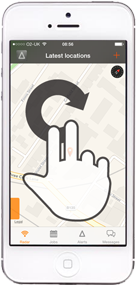
Rotating your fingers on the screen rotates the map.
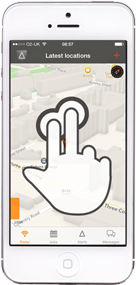
Slide two fingers up on the radar screen to change the angle at which you can view your vehicles on the map. This provides for a more 3D view and when zoomed in can show your vehicles among buildings.
When you’re zoomed in, then pinching or expanding two fingers on the map causes it to zoom or out.
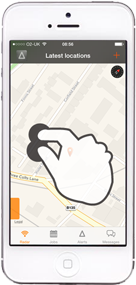
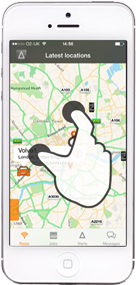
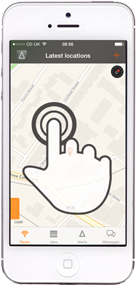
Double click on the map to zoom in.
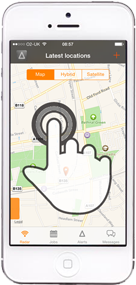
When you’re in the radar screen on the iPhone, pressing and holding on the map will cause the map type options to appear. The options are displayed for a few seconds and allow you to easily switch between standard map view, hybrid or satellite view. Particular useful if you want to see a photo quality image of where your vehicle is parked.
Sliding in from the left on the orange tab on the radar screen shows you a list of all your vehicles. You can then click on each one to find it on the map, then zoom in or out. You can also refresh the map, and get further information and settings. Sliding back from right to left closes the list.
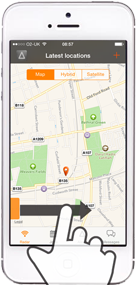
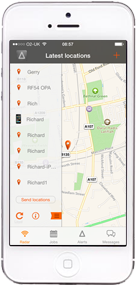
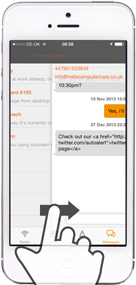
You can also slide in from the left on other screens such as the jobs screen and messaging screen to bring back the previous screen.
Find out more about:
The Digital Champion awards highlight digital businessess who are changing their markets; and creating new markets through the application of digital technology.
Digital technology will underpin Britain’s economic recovery, enabling UK businesses to unlock new markets, raise productivity and improve operating practices.
The “Digital Champion” award recognises UK-registered businesses that are challenging traditional industry and business practices; building a successful business on the back of such disruptive activity; and acting as a champion for the new digital economy.
AutoAlert’s digital approach to job management is creating a disruptive influence to all those industries which use remote workers including electrician and plumbers, security companies, transport and logistics and facilities managers.
AutoAlert’s mission is to eradicate paper based job sheets.
Millions of jobs sheets are created each day to provide job details to remote workers such as electricians and plumbers and to get information back about the work they’ve done on each job.
Unfortunately the process is labour intensive, involves lots of duplication, especially as more subcontractors are involved in the job and is opaque with no one knowing what is happening with each job until the job sheet is returned – often weeks later.
AutoAlert’s solution is a “social network for blue collar workers” which allows companies to connect to each other, send and receive jobs, then monitor and share the status of their jobs as they’re updated in the field by the engineer on their mobile phone.
AutoAlert provides clarity over what is happening as it happens, this leads to less anxiety, less chasing employees and more time for other tasks.
We are small in size but big in ambition. We have almost 20,000 customers using our platform but believe we can get millions due to the massive value our customers derive in connecting to their own customers and suppliers and being able to share the status of their jobs.
Paper based job sheets are wasteful and inefficient. No one knows what is happening with a job until the job sheet is returned.
By automating the process and by allowing engineers to update the job sheet on their mobile phone when they’re doing the job rather than filling out job sheets at the end of the day, or week this means everyone is aware what is happening as it happens.
This means no waiting around for job sheets, no difficult to read or missing information and no chasing remote workers by telephone.
Job details can be updated in the office or on site. The information is immediately available to all concerned ensuring customers, suppliers and engineers can respond immediately to any changes.
As the list of jobs is available on your mobile telephone, you can see any new jobs that have arrived and add them into your working day rather than having to come back to the office to pick up additional jobs.
If a job is not viewed, or if there is any delay, then alerts are generated to all concerned so any issues can be resolved or the job reallocated to another engineer.
Mobile telephones and the mobile web are an integral part of our “blue collar social network”. In the past, remote workers got information about their jobs on a piece of paper. A form was then completed once the job was done and taken back to the office often the next day or even a week or so later.
Handwritten information is often difficult to read and information may be missing. If the job sheets are returned days or even weeks later then this can lead to additional problems and disputes when raising invoices. Unfortunately, by this time the information is no longer fresh in everyones mind.
By using a mobile telephone to update the job details, the engineer gets the information in real time with text or push notifications when a new job has arrived. They can update the job while they are on site and while the information is still fresh in their minds meaning less errors, less chasing and quicker and more accurate invoicing.
Other companies are now using mobile telephones to provide a more simple, real time way of updating job sheets. They work well for individual companies but fall down when more than one company is involved in the job.
With AutoAlert, we’ve learnt from leading social networking companies such as Dropbox, Twitter and Facebook and have developed a connected system that works right the way along the supply chain, no matter how many companies are involved in each job.
We continue to learn and innovate, we speak to our customers regularly and spend time with them to understand how they are using our platform, how we can make it easier to use and how we can improve their lives. We also get thoughts and inspiration from other successful companies whether they’re working in related fields or in completely separate areas.
In terms of entrepreneurialiasm, i believe one key trait stands out – determination. We’ve faced many ups and downs, we’ve changed and improved our strategy and have now got to a stage where we have almost 20,000 customers using our platform with ambitions for millions more.
We have been working with a number of key customers since 2009. They were using our GPS tracking technology to help manage their vehicles and engineers. However, they wanted to expand, they were getting interest from large national companies but were concerned that they wouldn’t have the time and resources to manage the subcontractors that would be required to take on these new contracts.
Consequently we worked together to develop our job management software in order that they could better manage their jobs and workers.
We now have over 18,000 customers using our system. We have processed over 4,000 jobs with a value of approximately £1 million.
We have eradicated about 5,000 paper based job sheets and 15,000 telephone calls.
We have also allowed our customers to expand and take on more business. We estimate our customers have saved about £160,000 in costs by being able to reduce duplication, paperwork and calls to field workers to find out where they are.
At AutoAlert we’re keenly aware of the need for innovation. Both to set us apart from the competition and also to improve our own customerss working lives. We want to be special and we want to give our customers the tools so that they can be special too.
We have won a number of awards including Best Aftermarket product for the Telematics Industry – where we were competing with large multinationals including GM Motors.
Find out more about how AutoAlert job management software can benefit your business.
I often find myself searching for directions on my computer but then want to view those directions on my phone.
Fortunately with the cloud, this is pretty easy and doesn’t need you to search again from scratch on your phone.
If you don’t already know how to get directions from your desktop on to your smart phone, or from your computer to one of your colleagues phones simply and easily and with a minimum of clicks, then check our tips below:
If you’re using Apple Maps on your computer and on your iPhone or iPad. Simply press the sharing button and then select the device you want to share the directions with.
Then, on your iPhone (or iPad)
This will show you the directions on a map, you can also get turn by turn navigation by clicking the Start button.
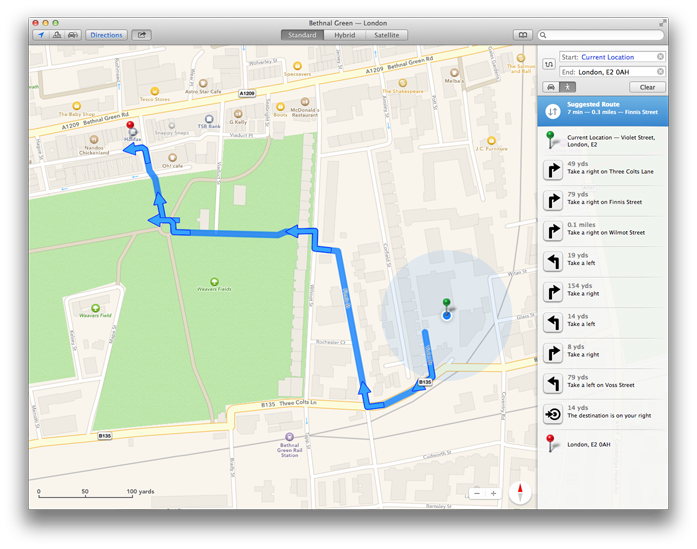
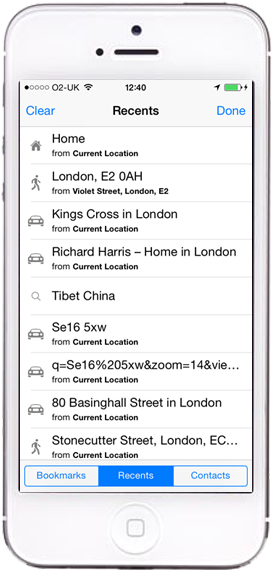
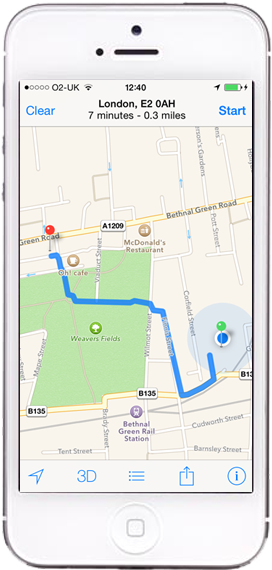
Provided you’re signed in to Google, if you’ve searched for directions on Google Maps on your web browser. The locations will automatically be shown on Google maps on any other device.
Open Google Maps on your phone, press the directions icon and then click the relevant location in your history to populate your origin or destination and get the directions between the two.
With AutoAlert Messaging, sending directions to someone else’s phone is very simple.
One of the benefits of using AutoAlert is the ability to cut and paste information from another application into AutoAlert and then send that as a message to one of your colleagues.
If you’re already got the directions from Google Maps, then simply
When your receive the text message on your phone, you can simply click on the URL in the message to open Google Maps on your phone with your directions.
If you’re logged into AutoAlert and want to send directions from one of your vehicles, or send directions from another address, then there are two simple ways to do this.
If you want to get directions from the current location of one of your vehicles, simply click on the vehicle, enter the destination in the Directions to field and click ![]() .
.
This will open your direction in google maps.
From there you can change the directions, add route options or change from driving to walking etc.
If you have Google Maps on your phone, you can open the application and use the two locations which are available in your history (see above).
If you want to send the directions to another phone, then copy the URL from your web browser, go back into AutoAlert and click the messages icon ![]() . You can then decide whether to send the message as an instant message to one of your connections or by SMS.
. You can then decide whether to send the message as an instant message to one of your connections or by SMS.
Clicking on the link in the message will automatically open the directions in your map application on your phone.
To get directions from a particular location,
This will open your direction in google maps.
From there you can change the directions, add route options or change from driving to walking etc.
If you have Google Maps on your phone, you can open the application and use the two locations which are available your history (see above).
If you want to send the directions to another phone, then copy the URL from your web browser, go back into AutoAlert and click the messages icon ![]() . You can then decide whether to send the message as an instant message to one of your connections or by SMS.
. You can then decide whether to send the message as an instant message to one of your connections or by SMS.
Clicking on the link in the message will automatically open the directions in your map application on your phone.
If you want to get directions from one location to another, then you can obviously do this via Google Maps, Apple Maps or a whole hosts of other applications.
However, if you want to get the directions from one of your vehicles to you, or to another location. Then this is simple to do using AutoAlert’s iOS Monitor application.
Simply open AutoAlert iOS Monitor, go to the radar screen, tap on your vehicle and then enter the address into the search bar and press done. T
This will launch Google Maps if you have it, otherwise it will launch Apple Maps on your phone with your directions ready including turn by turn navigation if required.
You can of course copy and paste any information you want into a message and send it via AutoAlert. This saves you the time and effort of having to write out a text from scratch on your phone.
Find out more about AutoAlert Messaging and our iOS Monitor application, and how they can benefit your business.